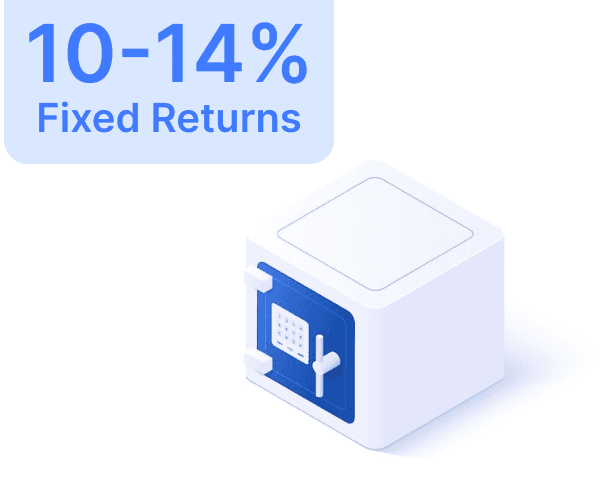NAV-Net Asset Value



What is NAV?
What is NAV?
What is NAV?
What is NAV?
NAV stands for Net Asset Value. It represents the market value per share of a particular mutual fund. It is calculated by subtracting the fund's liabilities from its total asset value and then dividing by the number of outstanding shares. To determine the NAV of each fund unit, you need to gather the market value of the portfolio and divide it by the total number of current fund units.
Typically, the unit cost of mutual funds starts at Rs. 10 and increases as the assets under management grow. Consequently, the more popular a mutual fund is, the higher its NAV.
NAV is most commonly used for open-end funds, where shares are not traded between shareholders.
NAV stands for Net Asset Value. It represents the market value per share of a particular mutual fund. It is calculated by subtracting the fund's liabilities from its total asset value and then dividing by the number of outstanding shares. To determine the NAV of each fund unit, you need to gather the market value of the portfolio and divide it by the total number of current fund units.
Typically, the unit cost of mutual funds starts at Rs. 10 and increases as the assets under management grow. Consequently, the more popular a mutual fund is, the higher its NAV.
NAV is most commonly used for open-end funds, where shares are not traded between shareholders.
NAV stands for Net Asset Value. It represents the market value per share of a particular mutual fund. It is calculated by subtracting the fund's liabilities from its total asset value and then dividing by the number of outstanding shares. To determine the NAV of each fund unit, you need to gather the market value of the portfolio and divide it by the total number of current fund units.
Typically, the unit cost of mutual funds starts at Rs. 10 and increases as the assets under management grow. Consequently, the more popular a mutual fund is, the higher its NAV.
NAV is most commonly used for open-end funds, where shares are not traded between shareholders.
Why is NAV Important?
Why is NAV Important?
Why is NAV Important?
Why is NAV Important?
NAV helps investors decide which investments to keep or withdraw from their portfolios by providing a reference value. Now that you know what NAV means in mutual funds, let's understand how it's calculated.
Net Asset Value Formula
The calculation of NAV is straightforward using the following formula:
NAV=Total Assets−Total LiabilitiesTotal Outstanding Shares\text{NAV} = \frac{\text{Total Assets} - \text{Total Liabilities}}{\text{Total Outstanding Shares}}NAV=Total Outstanding SharesTotal Assets−Total Liabilities
It's essential to accurately input the correct items under assets and liabilities to get an accurate NAV.
NAV helps investors decide which investments to keep or withdraw from their portfolios by providing a reference value. Now that you know what NAV means in mutual funds, let's understand how it's calculated.
Net Asset Value Formula
The calculation of NAV is straightforward using the following formula:
NAV=Total Assets−Total LiabilitiesTotal Outstanding Shares\text{NAV} = \frac{\text{Total Assets} - \text{Total Liabilities}}{\text{Total Outstanding Shares}}NAV=Total Outstanding SharesTotal Assets−Total Liabilities
It's essential to accurately input the correct items under assets and liabilities to get an accurate NAV.
NAV helps investors decide which investments to keep or withdraw from their portfolios by providing a reference value. Now that you know what NAV means in mutual funds, let's understand how it's calculated.
Net Asset Value Formula
The calculation of NAV is straightforward using the following formula:
NAV=Total Assets−Total LiabilitiesTotal Outstanding Shares\text{NAV} = \frac{\text{Total Assets} - \text{Total Liabilities}}{\text{Total Outstanding Shares}}NAV=Total Outstanding SharesTotal Assets−Total Liabilities
It's essential to accurately input the correct items under assets and liabilities to get an accurate NAV.
What Constitutes the Net Asset Value for Mutual Funds?
What Constitutes the Net Asset Value for Mutual Funds?
What Constitutes the Net Asset Value for Mutual Funds?
What Constitutes the Net Asset Value for Mutual Funds?
Unlike stocks, mutual funds do not trade in real-time. Their NAV is calculated based on the end-of-day market value of various assets and liabilities.
Assets
The assets of a mutual fund include the cumulative market value of the fund’s investments, receivables, cash, cash equivalents, and other accrued income. This market value is calculated at the end of each day based on the closing prices of the securities in the fund's portfolio. The assets may also include liquid assets, cash, interest payments, dividends, and other items.
Liabilities
The liabilities of a mutual fund include outstanding payments, money owed to lenders, and other fees and charges owed to associated entities. Liabilities may also include foreign obligations, such as shares for non-residents, pending payments to foreign entities, and sale proceeds yet to be settled. Additionally, liabilities encompass accrued expenses, including utilities, staff salaries, operating expenses, distribution, and management fees.
Unlike stocks, mutual funds do not trade in real-time. Their NAV is calculated based on the end-of-day market value of various assets and liabilities.
Assets
The assets of a mutual fund include the cumulative market value of the fund’s investments, receivables, cash, cash equivalents, and other accrued income. This market value is calculated at the end of each day based on the closing prices of the securities in the fund's portfolio. The assets may also include liquid assets, cash, interest payments, dividends, and other items.
Liabilities
The liabilities of a mutual fund include outstanding payments, money owed to lenders, and other fees and charges owed to associated entities. Liabilities may also include foreign obligations, such as shares for non-residents, pending payments to foreign entities, and sale proceeds yet to be settled. Additionally, liabilities encompass accrued expenses, including utilities, staff salaries, operating expenses, distribution, and management fees.
Unlike stocks, mutual funds do not trade in real-time. Their NAV is calculated based on the end-of-day market value of various assets and liabilities.
Assets
The assets of a mutual fund include the cumulative market value of the fund’s investments, receivables, cash, cash equivalents, and other accrued income. This market value is calculated at the end of each day based on the closing prices of the securities in the fund's portfolio. The assets may also include liquid assets, cash, interest payments, dividends, and other items.
Liabilities
The liabilities of a mutual fund include outstanding payments, money owed to lenders, and other fees and charges owed to associated entities. Liabilities may also include foreign obligations, such as shares for non-residents, pending payments to foreign entities, and sale proceeds yet to be settled. Additionally, liabilities encompass accrued expenses, including utilities, staff salaries, operating expenses, distribution, and management fees.
How is NAV Relevant for Investors?
How is NAV Relevant for Investors?
How is NAV Relevant for Investors?
How is NAV Relevant for Investors?
Investors often equate NAV with the price of an equity share, but the calculations differ. The price of equity shares includes only the liquid assets, whereas NAV considers both liquid and non-liquid assets. Consequently, total equity reflects a company's working capital, while NAV represents the company's total monetary worth.
Understanding NAV helps investors make informed decisions about which funds to invest in.
Investors often equate NAV with the price of an equity share, but the calculations differ. The price of equity shares includes only the liquid assets, whereas NAV considers both liquid and non-liquid assets. Consequently, total equity reflects a company's working capital, while NAV represents the company's total monetary worth.
Understanding NAV helps investors make informed decisions about which funds to invest in.
Investors often equate NAV with the price of an equity share, but the calculations differ. The price of equity shares includes only the liquid assets, whereas NAV considers both liquid and non-liquid assets. Consequently, total equity reflects a company's working capital, while NAV represents the company's total monetary worth.
Understanding NAV helps investors make informed decisions about which funds to invest in.
Calculating NAV
Calculating NAV
Calculating NAV
Calculating NAV
There are two primary methods for calculating NAV:
Daily NAV Calculation
Mutual fund companies evaluate the total worth of their portfolio daily after the stock market closes at 3:30 pm. The next day's market reopens with the previous day's closing prices. Fund houses deduct all expenses to determine the daily NAV using the above formula.
General NAV Calculation
The general NAV calculation reflects the price of an equity share, given by the cumulative cost of individual shares. This calculation indicates the market value of a particular asset and fluctuates with market conditions.
Role of NAV in Fund Performance
Many investors mistakenly believe that a lower NAV means a cheaper and better investment. However, NAV does not correlate with a fund’s performance. It merely shows how the underlying assets have performed over time. Therefore, investors should not use NAV as the sole deciding factor when choosing funds. Instead, they should consider the fund's returns and historical performance to make an informed decision.
Conclusion
NAV is a useful metric for understanding how a fund performs daily but does not indicate how lucrative a fund is. Investors should look at the current cost of funds and their historical performance before deciding to invest.
There are two primary methods for calculating NAV:
Daily NAV Calculation
Mutual fund companies evaluate the total worth of their portfolio daily after the stock market closes at 3:30 pm. The next day's market reopens with the previous day's closing prices. Fund houses deduct all expenses to determine the daily NAV using the above formula.
General NAV Calculation
The general NAV calculation reflects the price of an equity share, given by the cumulative cost of individual shares. This calculation indicates the market value of a particular asset and fluctuates with market conditions.
Role of NAV in Fund Performance
Many investors mistakenly believe that a lower NAV means a cheaper and better investment. However, NAV does not correlate with a fund’s performance. It merely shows how the underlying assets have performed over time. Therefore, investors should not use NAV as the sole deciding factor when choosing funds. Instead, they should consider the fund's returns and historical performance to make an informed decision.
Conclusion
NAV is a useful metric for understanding how a fund performs daily but does not indicate how lucrative a fund is. Investors should look at the current cost of funds and their historical performance before deciding to invest.
There are two primary methods for calculating NAV:
Daily NAV Calculation
Mutual fund companies evaluate the total worth of their portfolio daily after the stock market closes at 3:30 pm. The next day's market reopens with the previous day's closing prices. Fund houses deduct all expenses to determine the daily NAV using the above formula.
General NAV Calculation
The general NAV calculation reflects the price of an equity share, given by the cumulative cost of individual shares. This calculation indicates the market value of a particular asset and fluctuates with market conditions.
Role of NAV in Fund Performance
Many investors mistakenly believe that a lower NAV means a cheaper and better investment. However, NAV does not correlate with a fund’s performance. It merely shows how the underlying assets have performed over time. Therefore, investors should not use NAV as the sole deciding factor when choosing funds. Instead, they should consider the fund's returns and historical performance to make an informed decision.
Conclusion
NAV is a useful metric for understanding how a fund performs daily but does not indicate how lucrative a fund is. Investors should look at the current cost of funds and their historical performance before deciding to invest.
What is Net Asset Value (NAV)?
NAV stands for Net Asset Value, representing the market value per share of a mutual fund. It is calculated by subtracting the fund's liabilities from its total asset value and dividing by the number of outstanding shares.
How is NAV calculated?
The NAV is calculated using the following formula:
NAV=Total Assets−Total LiabilitiesTotal Outstanding Shares\text{NAV} = \frac{\text{Total Assets} - \text{Total Liabilities}}{\text{Total Outstanding Shares}}NAV=Total Outstanding SharesTotal Assets−Total Liabilities
This calculation includes both liquid and non-liquid assets and all liabilities of the fund.
Why is NAV important for investors?
NAV provides a reference value that helps investors decide which investments to keep or withdraw from their portfolios. It reflects the market value of the mutual fund's units and helps investors understand the fund's performance.
Does a higher NAV mean a better mutual fund?
Not necessarily. NAV simply shows the current value of the fund's assets minus its liabilities. A higher NAV does not automatically mean better performance. Investors should consider the fund's historical performance, returns, and other factors when making investment decisions.
How often is NAV calculated and updated?
NAV is typically calculated and updated daily by mutual fund companies after the stock market closes. The next day's market reopens with the previous day's closing prices, and all expenses are deducted to determine the daily NAV.
What is Net Asset Value (NAV)?
NAV stands for Net Asset Value, representing the market value per share of a mutual fund. It is calculated by subtracting the fund's liabilities from its total asset value and dividing by the number of outstanding shares.
How is NAV calculated?
The NAV is calculated using the following formula:
NAV=Total Assets−Total LiabilitiesTotal Outstanding Shares\text{NAV} = \frac{\text{Total Assets} - \text{Total Liabilities}}{\text{Total Outstanding Shares}}NAV=Total Outstanding SharesTotal Assets−Total Liabilities
This calculation includes both liquid and non-liquid assets and all liabilities of the fund.
Why is NAV important for investors?
NAV provides a reference value that helps investors decide which investments to keep or withdraw from their portfolios. It reflects the market value of the mutual fund's units and helps investors understand the fund's performance.
Does a higher NAV mean a better mutual fund?
Not necessarily. NAV simply shows the current value of the fund's assets minus its liabilities. A higher NAV does not automatically mean better performance. Investors should consider the fund's historical performance, returns, and other factors when making investment decisions.
How often is NAV calculated and updated?
NAV is typically calculated and updated daily by mutual fund companies after the stock market closes. The next day's market reopens with the previous day's closing prices, and all expenses are deducted to determine the daily NAV.
What is Net Asset Value (NAV)?
NAV stands for Net Asset Value, representing the market value per share of a mutual fund. It is calculated by subtracting the fund's liabilities from its total asset value and dividing by the number of outstanding shares.
How is NAV calculated?
The NAV is calculated using the following formula:
NAV=Total Assets−Total LiabilitiesTotal Outstanding Shares\text{NAV} = \frac{\text{Total Assets} - \text{Total Liabilities}}{\text{Total Outstanding Shares}}NAV=Total Outstanding SharesTotal Assets−Total Liabilities
This calculation includes both liquid and non-liquid assets and all liabilities of the fund.
Why is NAV important for investors?
NAV provides a reference value that helps investors decide which investments to keep or withdraw from their portfolios. It reflects the market value of the mutual fund's units and helps investors understand the fund's performance.
Does a higher NAV mean a better mutual fund?
Not necessarily. NAV simply shows the current value of the fund's assets minus its liabilities. A higher NAV does not automatically mean better performance. Investors should consider the fund's historical performance, returns, and other factors when making investment decisions.
How often is NAV calculated and updated?
NAV is typically calculated and updated daily by mutual fund companies after the stock market closes. The next day's market reopens with the previous day's closing prices, and all expenses are deducted to determine the daily NAV.
Author

Harish Malhi
Read More 📖


Axis Bank Credit Card Net Banking
Axis Bank Credit Card Net Banking
August 5, 2024
August 5, 2024




PNB Fixed Deposit (FD) Interest Rates
PNB Fixed Deposit (FD) Interest Rates
August 5, 2024
August 5, 2024




Linking Aadhaar to Your Punjab National Bank Account
Linking Aadhaar to Your Punjab National Bank Account
August 5, 2024
August 5, 2024




PNB SIP Calculator
PNB SIP Calculator
August 5, 2024
August 5, 2024




How to Close a PNB Account Online & Offline?
How to Close a PNB Account Online & Offline?
August 5, 2024
August 5, 2024




TDS Refund - How to Claim TDS Refund
TDS Refund - How to Claim TDS Refund
August 5, 2024
August 5, 2024


View More




